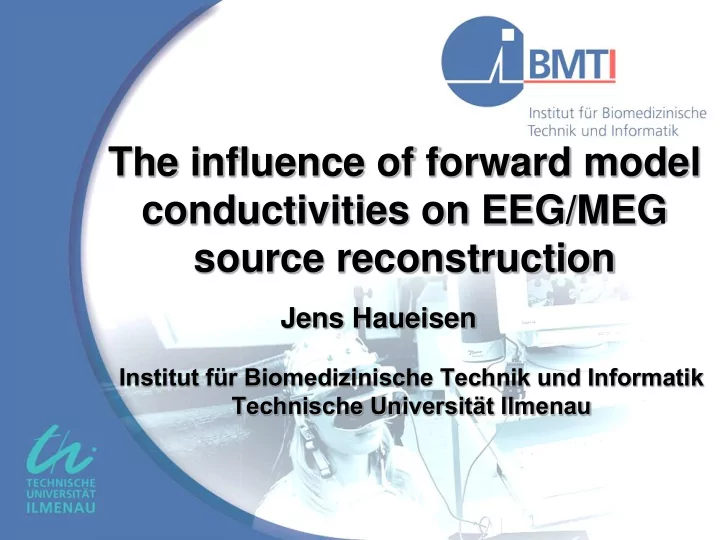

The influence of forward model conductivities on EEG/MEG source reconstruction Jens Haueisen Institut für Biomedizinische Technik und Informatik Technische Universität Ilmenau
Introduction • How does volume conduction influence source estimation? • How does anisotropy influence source estimation?
Overview 1. Finite Element Modeling 1. Software: SimBio and Galerwin 2. Conductivity and anisotropy data 2. Sensitivity analysis 1. Animal studies 2. Human studies
SimBio and NeuroFEM Image Registration (T1, T2, PD) Segmentation Mesh Generation BEM/FEM Forward toolbox Inverse toolbox Visualisation
Galerwin T1 weighted MR data: FEM model cross section: • 1.6 mm slice thickness, • resolution of 1 mm x 1 mm x 3.2 mm, • 102 slices, • 1,456,069 hexahedral elements (voxels) • 1 mm x 1 mm pixel size • adaptive JCG solver Schimpf, Haueisen et al., Parallel Computing, 1998
Conductivity and anisotropy data Human Diffusion Tensor Imaging Anisotropy map (FA) Anisotropy map color coded Diffusion tensor as ellipsoid Fiber tracking (main direction of strong anisotropic tensors) Böhr, Güllmar, Knab, Reichenbach, Witte, Haueisen: Brain Res, 2007
Conductivity and anisotropy data Rabbit imaging Flash3D T1 (isotropic resolution 0.625 mm) TSteam - DTI 633172 cubic elements (0.6mm)
Overview 1. Finite Element Modeling 1. Software: SimBio and Galerwin 2. Conductivity and anisotropy data 2. Sensitivity analysis 1. Animal studies 2. Human studies
Animal sensitivity analysis Simulations with a block of white matter Sagittal slice with C R 4 tissue types: • skin • skull • gray matter • artificial white matter block • source space with 3 layers of dipoles around the anisotropic block • dipole orientation left/right, rostral/caudal, and inferior/superior • anisotropic conductivity of 1:10 in caudal-rostral orientation
Animal sensitivity analysis Differences in the forward computations rad tang
Simulations with a block of white matter Values above the 0.8 percentile for RDM*, MAG, dipole shift, magnitude change and orientation change are visualized by red surfaces. Güllmar, Haueisen et al. IEEE TBME 2006
Experimental validation Anisotropic block in a torso phantom electric magnetic Liehr, Haueisen: Phys Med Biol, 2008
Animal sensitivity analysis Simulations with measured conductivity tensors Source localization error front Forward computation: anisotropic model Inverse: isotropic model back 1360 dipoles Dipole shift in mm Histogram of the dipole shift
Animal sensitivity analysis Simulations with measured conductivity tensors Dipole magnitude estimation error Magnitude change (relative to 1) Histogram of the dipole magnitude errors
Animal sensitivity analysis Simulations with measured conductivity tensors Dipole orientation estimation error Histogram of the dipole orientation errors Orientation change in deg
Sensitivity analysis Forward simulations with isotropic and anisotropic human head models Results: Correlation: above 0.98 Magnitude: more than 50% change Tissue anisotropy seems to have a minor influence on source localization but a major influence on dipole strength estimation. Haueisen et al., The influence of brain tissue anisotropy on human EEG and MEG. Neuroimage 15:159-166, 2002
Sensitivity analysis Simulations with conductivity changes of single voxels Results: Correlation: Change in A: 0.98 Change B-F: >0.999 Magnitude: Change in A: 2 - 60% Change B-F: < 1% Conductivity changes in the vicinity of the dipole influence source estimation. Haueisen et al., The influence of local conductivity changes on MEG and EEG. Biomed. Tech. 45 (7-8), 211 – 214, 2000
Human sensitivity analysis • 5 tissue types • 3.2 million cubic elements (1mm) • 130 electrodes • 25,000 dipoles perpendicular to cortical surface • anisotropies of 1:2, 1:5, 1:10 and 1:100 Comparison of isotropic and anisotropic model output by RDM and MAG mapped to each dipole position
Human sensitivity analysis right hemisphere left hemisphere Relative Difference Measure – outside view
Human sensitivity analysis right hemisphere left hemisphere Relative Difference Measure – inside view
Conclusions • Anisotropic volume conduction influences source strength and source orientation estimation more than source location estimation. • Local conductivity properties in the vicinity of the source crucially influence source estimation. • Model errors both on a local and a global scale are not Gaussian.
Thanks to: Daniel Güllmar Hannes Nowak Ceon Ramon Lars Flemming Michael Eiselt Paul H. Schimpf Jörg Schreiber Frank Gießler David S. Tuch Annegret Böttner Hartmut Brauer Van J. Wedeen Jürgen R. Reichenbach John S. George John W. Belliveau The SimBio Team: Carsten Wolters Alfred Anwander Thomas Knösche Matthias Dümpelmann … Financial support: European Union, German Ministry of Science
Recommend
More recommend